在没有任何配方性别对药物吸收影响的情况下,生物等效性研究的性别依赖结果:检验理论可能性
IF 4.3
3区 医学
Q1 PHARMACOLOGY & PHARMACY
引用次数: 0
摘要
将女性志愿者纳入生物等效性(BE)研究的争论集中在当药物用于两性时实现公平。女性群体的虚拟生物等效性(VBE)研究为解决这一差距提供了另一种方法,特别是能够利用生理和生物学中与性别相关的输入来描述虚拟生物等效性结果的可能差异。虽然根据一些动物研究提出了配方性别效应,但没有研究全面解决性别依赖的BE结果,特别是在没有这种对吸收的影响的情况下。这项研究为BE中潜在的性别依赖结果提供了理论背景。结果表明,对于参考产品(R)和试验产品(T)的吸收率之间的给定差异,在两性中是相似的,对作为BE评估指标之一的Cmax的影响可能是性别依赖的。在药代动力学参数的实际边界内,测试了各种假设情况[T与R的吸收率(ka)为25-100%,两性之间的消除率(ke)差异高达4倍]。这些模拟确定了男性和女性之间BE结果差异的参数空间。所观察到的效果与消除的性别依赖性差异有关,受分布体积变化或影响清除的酶丰度的影响。本文章由计算机程序翻译,如有差异,请以英文原文为准。
Sex-dependent outcomes of bioequivalence studies in the absence of any sex-by-formulation effects on the drug absorption: Examining theoretical possibilities
Arguments for including female volunteers in bioequivalence (BE) studies focus on achieving equity when drugs are intended for use in both sexes. Virtual bioequivalence (VBE) studies in female populations offer an alternative approach to address the gap, especially with ability to delineate likely differences in the outcome of BE using sex-related inputs in physiology and biology.
Whilst sex-by-formulation effects are suggested based on some animal studies, no research has comprehensively addressed sex-dependent BE outcomes, particularly in the absence of such effects on absorption. This study provides a theoretical background to potential sex-dependent outcomes in BE. It is demonstrated that, for a given difference between rate of absorption of a reference (R) and test (T) products, that is similar in both sexes, the impact on Cmax as one of the BE assessment indices might be sex dependent. Various hypothetical scenarios within realistic boundaries of pharmacokinetic parameters [25–100% for absorption rate (ka) of T vs. R, and up to 4-fold difference in elimination rate (ke) between sexes] were tested. These simulations identified parameter spaces where BE outcomes diverged between males and females. The observed effects are linked to sex-dependent differences in elimination, influenced by variations in volume of distribution or enzyme abundance affecting clearance.
求助全文
通过发布文献求助,成功后即可免费获取论文全文。
去求助
来源期刊
CiteScore
9.60
自引率
2.20%
发文量
248
审稿时长
50 days
期刊介绍:
The journal publishes research articles, review articles and scientific commentaries on all aspects of the pharmaceutical sciences with emphasis on conceptual novelty and scientific quality. The Editors welcome articles in this multidisciplinary field, with a focus on topics relevant for drug discovery and development.
More specifically, the Journal publishes reports on medicinal chemistry, pharmacology, drug absorption and metabolism, pharmacokinetics and pharmacodynamics, pharmaceutical and biomedical analysis, drug delivery (including gene delivery), drug targeting, pharmaceutical technology, pharmaceutical biotechnology and clinical drug evaluation. The journal will typically not give priority to manuscripts focusing primarily on organic synthesis, natural products, adaptation of analytical approaches, or discussions pertaining to drug policy making.
Scientific commentaries and review articles are generally by invitation only or by consent of the Editors. Proceedings of scientific meetings may be published as special issues or supplements to the Journal.

 求助内容:
求助内容: 应助结果提醒方式:
应助结果提醒方式:


